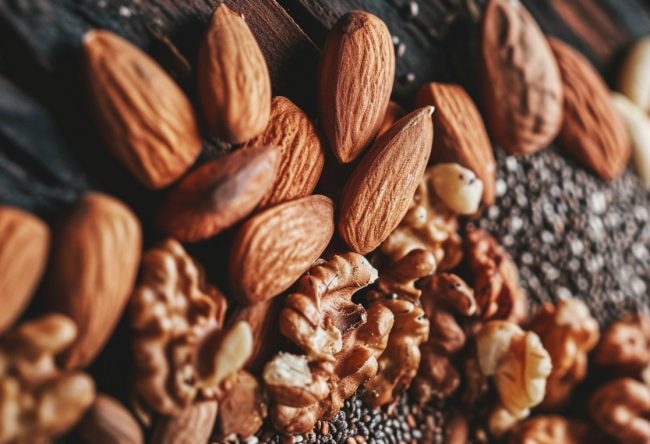What makes a farm the best? Is it the quality of the almonds and walnuts, the commitment to sustainable farming, or the deep-rooted family values that drive every harvest? The truth is, it’s all of the above
Best Almond and Walnut Farm: Briden Wilson Farm’s Nutritional Benefits
Some almonds have that perfect crunch, that rich, buttery snap when you bite into them. Some walnuts have that deep, earthy flavor that lingers—nutty but never bitter. But where do the best ones come from?
The truth is, it all starts at the source. The best almond and walnut farm isn’t a place where trees grow—it’s where generations of farmers work the land, perfecting their craft. It’s where soil, climate, and tradition come together to produce almonds and walnuts that actually taste the way nature intended.
And if you’re looking for the finest raw, fresh, natural nuts, you don’t have to look any further than the family-run farms of California’s Central Valley.
Briden Wilson Farm: Leading in Quality and Sustainability
Briden Wilson Farm out for delivering high-quality, natural farm products. The farm emphasizes sustainable practices to produce nutritious fruits and nuts. Every item they grow reflects a commitment to environmental responsibility. Customers value Briden Wilson Farm for its dedication to health and purity. The farm’s approach ensures that each product is both beneficial and eco-friendly.
Natural Raw Almonds: Packed with Nutrients
Natural Raw Almonds from Briden Wilson Farm are full of health benefits. Rich in protein, fiber, and essential vitamins, these almonds support a healthy diet. Grown without any artificial additives, they offer a pure choice for nutritious snacking. Regular consumption contributes to heart health and weight management. Briden Wilson Farm’s commitment to natural processes makes its almonds a healthy choice for everyone.
Organically Grown Raw Almonds: Eco-Friendly and Healthy
Organically Grown Raw Almonds at Briden Wilson Farm are produced without harmful chemicals or pesticides. Rich in Vitamin E and magnesium, these almonds are crucial for maintaining good health. Organic methods promote sustainability and protect the environment. Eating Briden Wilson Farm almonds supports personal health and the health of the planet. The farm guarantees its almonds meet strict organic standards for the benefit of its customers.
Why California Grows the Best Almonds and Walnuts
California produces almost 100% of the country’s almonds and over 90% of its walnuts. It’s the backbone of the entire nut industry.
But why? What makes California the perfect place for nut farming?

1. Perfect Climate, Perfect Nuts
In California’s Central Valley, the balance between wet winters and hot, dry summers creates the ideal environment for nut trees to thrive. The trees soak up winter rain, store energy, and then burst into bloom by mid-February, covering the orchards in delicate white flowers.
By mid-March, those flowers turn into tiny green nut buds, and by the end of summer, you’ve got fully grown, sun-ripened almonds and walnuts, ready for harvest.
2. Rich, Nutrient-Packed Soil
The deep, fertile soils of Kern County, Yolo County, and Fresno provide everything the trees need to develop the kind of almonds and walnuts that stand out in taste and quality.
3. Generations of Family Farming Expertise
Many of the best nut farms are small family farms, where knowledge is passed down through the generations. The farmers know when to skip the shortcuts and do things the right way, even if it takes longer.
Farms like Briden Wilson Farm understand that better than anyone. Their commitment to quality, tradition, and sustainability ensures that every batch of almonds and walnuts is grown with care and harvested at peak freshness.
What Makes the Best Almond and Walnut Farm?
Not all farms are created equal. The best ones focus on sustainability, quality, and tradition, ensuring that every almond and walnut is grown with care and expertise.
1. Sustainable Farming Practices
Great farms understand that the future of agriculture depends on responsible farming methods. Many of the best nut farms:
- Use minimal water by implementing drip irrigation systems.
- Protect pollinators by planting bee-friendly crops like wildflowers around their orchards.
- Limit waste by using nut byproducts for livestock feed and compost.
2. Unmatched Quality and Freshness
The best almond and walnut farm ensures that nuts are harvested at peak ripeness, processed carefully, and stored under the best conditions to preserve freshness.
High-quality almonds are known for their rich, buttery flavor, while top-tier walnuts have a bold, earthy taste. When grown and processed correctly, they provide an unbeatable healthy snack that’s perfect for eating, cooking, or even making nut-based products like nut butter and olive oil.
3. Family-Owned and Operated
Many of the top nut farms are small family farms, where generations work together to make every harvest meet the highest standards.
Briden Wilson Farm is a great example of that commitment to quality. Their family-run operation focuses on natural farming techniques, ensuring that every batch of almonds and walnuts is as fresh and flavorful as possible.

From Bloom to Harvest: The Life Cycle of an Almond and Walnut Tree
Spring: The Bloom Begins
Every year, between mid-February and mid-March, nut trees burst into bloom. Almond orchards are covered in a breathtaking sea of white flowers, while walnut trees slowly begin their growth cycle.
Bee pollination is key at that stage, as it determines the future yield of the farm. Many nut farmers work with local beekeepers to ensure successful pollination.
Summer: Growth and Maturity
As temperatures rise, nuts begin to develop. Almonds grow inside a protective hull, while walnuts mature within a thick green shell. By mid-summer, the hulls begin to split, signaling that harvest is near.
Fall: Harvest Time
Between September and November, farmers begin the harvest. Special machinery shakes the trees, causing nuts to fall to the ground, where they dry naturally in the sun. Once dried, they are collected, sorted, and processed.
The Health Benefits of Almonds and Walnuts
Both almonds and walnuts are packed with healthy nutrients, making them a top choice for anyone looking to improve their well-being.
Almonds vs. Walnuts: Nutritional Breakdown
- Almonds are rich in vitamin E, magnesium, and heart-healthy fats.
- Walnuts are a top source of omega-3 fatty acids, which support brain health.
- Both nuts are known to help lower cholesterol and support heart health.
How to Find the Best Almond and Walnut Farm
Want to get your hands on the freshest almonds and walnuts? Here’s what to look for:
- A Family-Owned Operation – Small family farms often produce the highest quality nuts, as they prioritize freshness and sustainability.
- Great Reviews – Before you shop, check reviews to see what other customers have to say.
- Direct Farm Stores – Many farms have a store from where you may buy raw, fresh nuts straight from the source.
- Variety of Products – The best farms offer more than whole nuts—they also sell nut-based products like nut butter, flour, and olive oil.
Briden Wilson Farm is a standout in the category. Their commitment to quality, care, and family farming makes them a top choice for anyone looking for truly fresh almonds and walnuts.
Final Thoughts: Why the Best Almond and Walnut Farms Matter
The best almond and walnut farms preserve a way of life. It’s about family, tradition, and a deep respect for the land.
So next time you’re craving fresh, natural nuts, skip the mass-produced stuff and go for the real deal. Find a farm that takes care in every step of the process, one that’s been doing it the right way for years.
And if you ever get the chance to visit an almond orchard or a walnut grove, don’t miss it—you’ll never look at the nuts the same way again.

